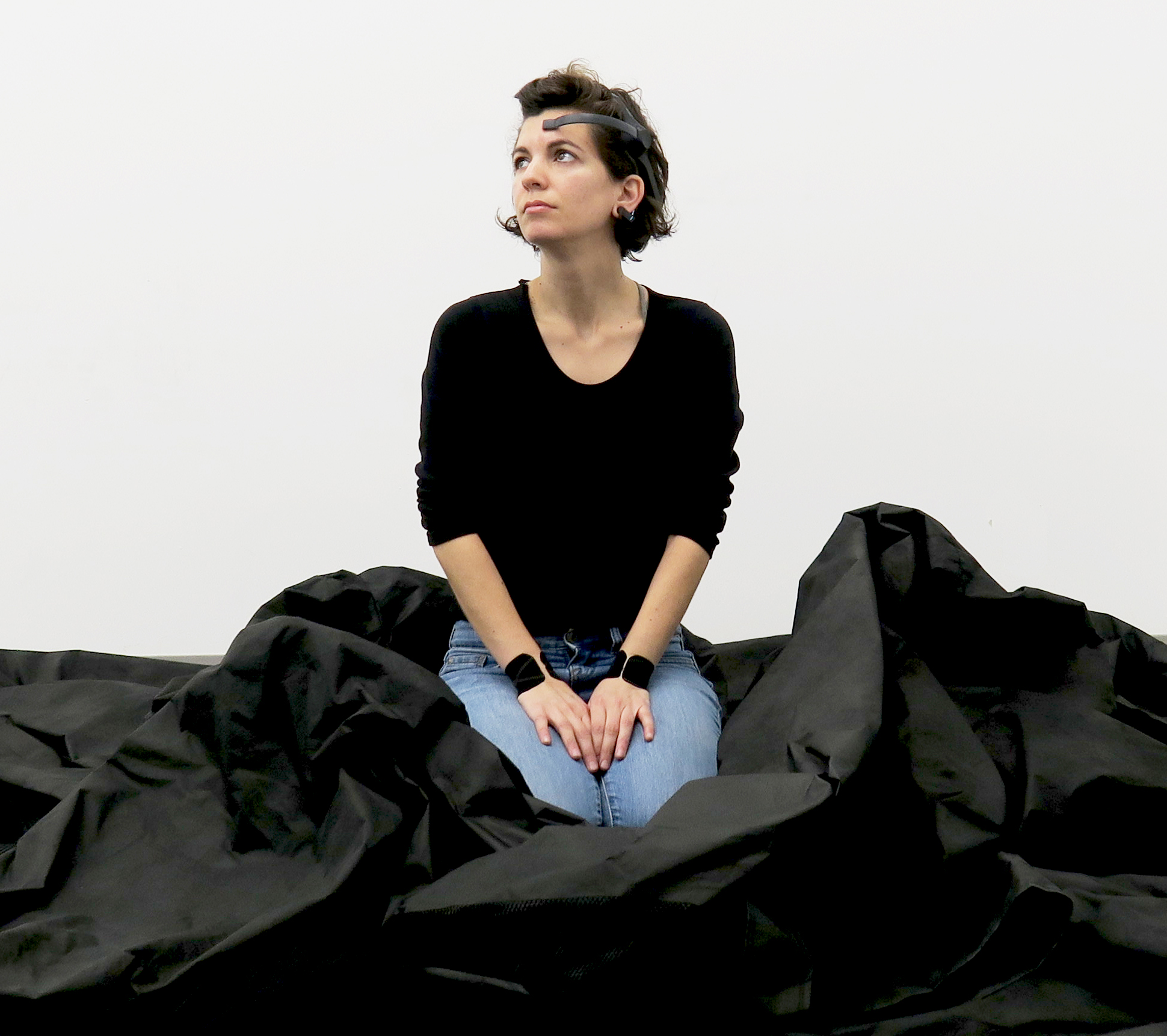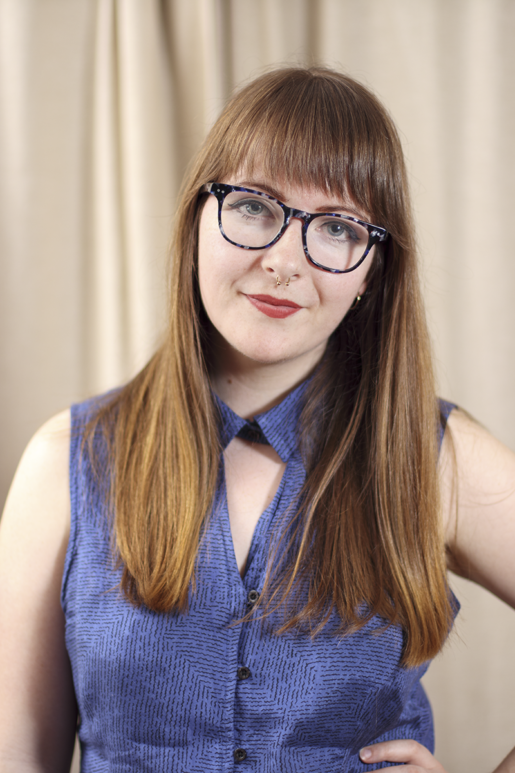Student Profile | Ateret Buchman

Posted on | Updated
The fourth year student is exploring mind-driven interactions, by using brain waves to create personalized experiences.
Fourth year Interaction Design student Ateret Buchman recently exhibited part of her project series, Minded Objects, in the Diffuser Gallery. Participants were invited to wear a headset monitoring their brain waves, which was connected to an inflating castle. As participants sat with the headset, their mental activity would gradually inflate and deflate the castle.
Ateret told us more about her work and process, and shared her advice for aspiring Interaction Designers.
Why did you choose Emily Carr for your studies? What has your student experience been like?
I came to Emily Carr because it seemed to sit the heart of the local art and design community, and I wanted to be part of that. I was working solo for a really long time and I wanted to reach out and connect with others. I remember the initial wonder I felt coming to a place with so many individuals who explore and engage with the world creatively. It was as if many of the internal conversations I had been having suddenly existed outside of my head too, so from the very beginning it felt like it was the right place for me to be. I also appreciated the fact that it was a smaller, more intimate university.
What led to your interest in Interaction Design? How would you describe your practice?
I would say my current practice revolves around making works that translate and facilitate thinking, works that invite others to the conversation. This is what drives me most right now, but it’s always in flux. In Emily Carr lingo, right now I’m somewhere between service design, new media art, social practice and critical making. It’s all over the place, and that’s how I like it.
When I began my Foundation year I had no particular destination in mind, I wanted a meaningful learning experience rather than a degree, and I allowed my gut feeling to guide me in my journey here. I chose design because as a discipline, it sits at a very interesting crossroad between art, craft, technology, and market. Within it, l was drawn to interaction design because it was (and still is) a bit less defined as a field, and can really encompass quite a lot, which leaves room for play and exploration and allows you to craft your own niche in it.
Tell me about your graduate project!
My project is a series of mind driven interactive experiences called Minded Objects. It’s a collection of three different designed environments, in which an EEG headset that records the brain’s electrical activity gets connected to different devices that are activated by real-time brain data. Each interactive environment I created gives this data a different set of meanings. I like to think of these minded objects as outputs/metaphors.
The first one was a mind controlled kitchen, the second was an inflating/deflating mind castle, and the third is an interactive short brainwave driven film. It’s one of these projects that are a bit difficult to describe but very easy to understand through experience, which is partly the goal of it—to show rather than tell how the line between our perception of object and subject can dissolve, and to critically explore the role of designers as meaning makers, especially when it comes to emerging technologies. I have been working with EEG and neurofeedback loops as a medium for a while now, trying to explore the fine details of mind-driven interactions, from how it affects our body, space, relationships with others as well as the ethical issues it raises.
I started developing this project while taking Garnet Hertz’s Disobedient Objects course, where I got the best two words of advice one could get when coming up with ideas that seem a bit too wild: do it.
How did you come to work with the Health Design Lab, and what projects did you work on there?
I joined the HDL team on my third year here because I was excited about the opportunity to design for public good, and I wanted to direct my energy towards real world issues. Also, from an interaction design perspective, I wanted to improve my co-design and participatory design skills, which I totally did through this.
I had the opportunity to work on two different projects at the HDL: the first was in collaboration with the Pacific Autism Family Network and the Michael Smith Foundation for Health Research. The goal was to gain better understanding of how researchers and families in the Autism community currently communicate, and to generate ideas for improving future knowledge exchange. Our team created an interactive installation and facilitated a series of co-creation workshops for researchers and families of individuals on the spectrum. Through the workshops we gained insights into the ways families and researchers currently navigate and share information, we recognized barriers to information exchange, and generated ideas to improve future access to ASDs resources and research.
The second project I participated in was quite different in terms of its scope and process. It was a collaboration with MindfulGarden, a local health-tech company that created an interactive therapeutic platform designed to reduce anxiety and aggression in seniors with delirium and/or dementia in hospitals and long-term care facilities. We optimized the user experience of their platform for both caregivers and patients by using a human-centered design methodology, and generated design considerations and insights surrounding the device’s hardware and interactive video content.
From a personal perspective, each of these projects was a meaningful learning opportunity. I can definitely say that my practice was enriched by what I learned through this work and through Caylee Raber’s awesome guidance.
What do you do in your work with the Federal Department of Canadian Heritage?
It’s an interesting one— I could never imagine that a creative position of this kind would ever exist, but surprisingly, it does. I currently work at the Department of Canadian Heritage as a Design Thinking Advisor, and my task is to integrate creative thinking and different design tools and strategies into their workplace, finding the areas that would benefit from this complementary set of tools. Much of what I do revolves around building knowledge through experimentation and collaboration with others, and while it is generally more common to hire designers to help tackle discrete issues, here there is a real opportunity to build design as a capability and make it part of the organizational culture.
Did your experience working with the HDL help you prepare for that position?
Very much so. It’s all about tailoring the right thing for the context, asking what are the best tools we have for a given challenge, and inventing them if they don’t already exist. Working on more than one project with the HDL taught me that each project has its own unique ecosystem, and that although they may seem very different, at the core they all start with building connections, understanding and empathy.
Any advice to Foundation students or prospective students who are interested in Interaction Design?
Yes! Curate an educational journey that’s right for you, even if it doesn’t fit into a given mold (our academic advising team really rocks, they can help you out with all the details). Figure out what are the conditions that support real learning for you-- for myself I found that reducing my course load to part-time was one of the best decision I made. It eliminated a lot of unnecessary systematic stress that was not conductive to any learning.
For Interaction design students- if you are interested in INTD beyond
UX/UI and want to explore interaction as a medium in the wider sense, consider joining the Social Practice + Community Engagement (SPACE) Minor. It complements Interaction Design really well, and
will add depth to your practice.
Do you know another Emily Carr student we should profile? Get in touch!


